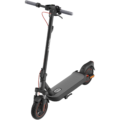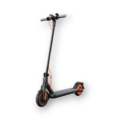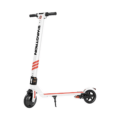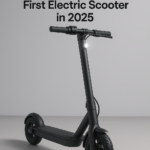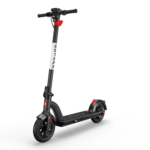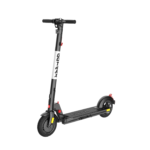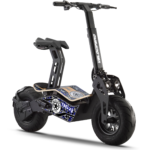- Home
- Scooters
- Electric Scooters
- Xiaomi Electric Scooter 4 Pro Max
Xiaomi Electric Scooter 4 Pro Max



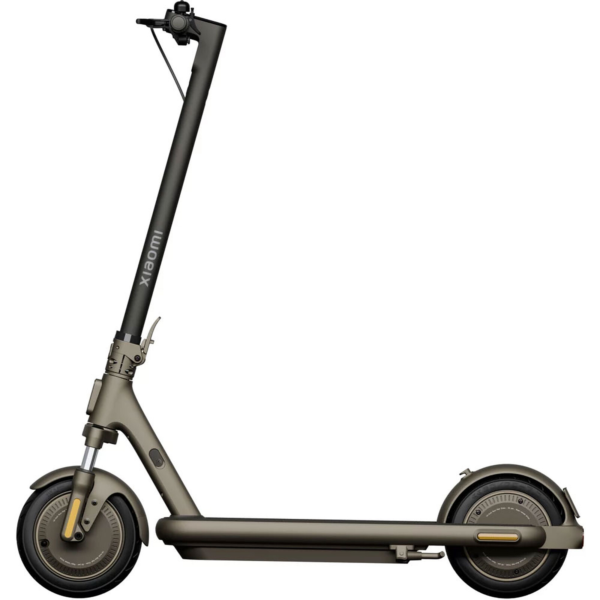
- Battery Range: 60 km
- Top Speed: 25 km/h
- Motor Power: 400 W rated
- Weight Capacity: 110 kg
- Charging Time: 3 hours
- Scooter Weight & Portability: 21.3 kg
PROS
- Front dual-cylinder suspension + 10″ run-flat tires = calmer ride and fewer flats
- Rear-wheel drive traction with smooth, predictable throttle and regen
- Auto-light headlamp, integrated indicators, and larger taillight improve visibility
- Steel alloy body with quiet 3-step fold feels solid month after month
- Optional fast charging (~3 h) supports busy schedules
CONS
- 25 km/h cap may feel limiting to speed seekers
- 21.3 kg weight isn’t ideal for frequent stair carries
- No rear suspension; comfort relies on front fork + tire compliance
Introduction: Big-city range, calmer ride, fewer hassles
The Xiaomi Electric Scooter 4 Pro Max Specifications signal a commuter that aims to make daily rides predictable, comfortable, and low-maintenance. Instead of chasing headline speeds, Xiaomi pairs a rear-drive 400 W motor (960 W max) with front dual-cylinder suspension and 10-inch run-flat tires. As a result, the scooter rolls through patchy asphalt without the harsh chatter that plagues rigid frames. It also keeps your hands fresh during longer trips. You still get the standard Xiaomi polish—clear dash, one-button controls, and app tweaks—yet the 4 Pro Max adds meaningful upgrades: auto-light mode, integrated indicators, and 3-hour fast-charge capability (with the optional charger).
Moreover, Xiaomi balances strength and practicality. The frame uses high-strength alloy steel, which helps the stem feel planted at speed and quiet over months of folding. Meanwhile, an IPX4 rating and a tidy cable layout support wet-morning commutes, provided you ride with care. Altogether, this model targets riders who value consistency and comfort over raw speed numbers. If your day involves real streets, mixed surfaces, and stop-and-go traffic, the 4 Pro Max feels designed for you.
Motor & Drive: Push from the rear, stay composed up front
Rear-wheel drive changes the way a scooter behaves. Because the 4 Pro Max pushes from behind, the front wheel tracks more cleanly across painted lines, pavers, and light grit. You roll on the throttle, and the scooter leans forward without tugging the bars. That steady push builds confidence on narrow streets and keeps your line predictable when you weave past parked cars.
Power delivery stays smooth rather than jumpy. In Standard mode, the scooter glides to 20 km/h with a relaxed cadence that conserves energy. Switch to Sport, and it rises to the 25 km/h cap briskly, yet without a spike that would unsettle the chassis. This profile suits city life: you can start decisively from a light, match bike-lane flow, and back off gently as traffic compresses.
Hills tell the same story. With up to 22% claimed climb ability, the 4 Pro Max does not stall on short rises, yet it never lunges. Instead, it maintains pressure while you pick a clean line around seams or grates. Because the front stays composed, you get time to look where you want to go instead of fighting for balance. In brief, the drive system favors control and traction over theatrics, which is exactly what most commuters need.
Speed & Flow: 25 km/h done right
While some riders dream of higher speed, daily flow rewards predictability. The 25 km/h cap keeps braking distances manageable, reduces fatigue on rigid decks, and aligns with many regional limits. In practice, you gain more from smooth throttle mapping and light engine-brake feel than from another 5 km/h on the top end. You nudge the lever and move; you ease off and feel a gentle slow-down; you squeeze the brake and the system layers on stopping power.
Because the scooter communicates each phase clearly, people around you understand your intent sooner. Drivers read a steady approach, cyclists notice your deceleration, and pedestrians see your indicators blink before you turn. Consequently, lane merges and path passes feel cooperative rather than confrontational. Over a week of mixed rides, that calm rhythm saves both energy and nerves.
Suspension, Tires & Ride Comfort: Smooths the edges, saves your hands
Two components define the 4 Pro Max ride: front dual-cylinder suspension and 10-inch run-flat tires. The suspension handles the sharp hits—expansion joints, patch edges, and brick seams—so the stem doesn’t hammer your wrists. Meanwhile, the run-flat tires carry volume and internal structure that soften vibration and resist punctures. Together, they remove the two most common sources of commuter frustration: stingy impacts and flat tires.
Additionally, the larger contact patch and the rear-drive layout work in tandem. When you tip into a turn on worn asphalt, the front rolls roundly rather than skipping. When you cross a raised seam while braking, the tire keeps its shape and the fork takes the edge off. As a result, you keep a looser grip and a more relaxed posture, which pays off on longer routes.
To be clear, this is still a city scooter without rear suspension. You will feel the road. Yet the mix of front suspension and run-flat tires moves comfort well above older rigid designs—especially on real-world surfaces just shy of smooth.
Braking & Safety: Progression, not panic
Safe stops depend on sequence. Here, the rear E-ABS engages first, adding a mild engine-brake effect as you roll off. Then, as you pull the lever, the front mechanical drum supplies firm, linear bite. Because the onset is progressive, weight transfers cleanly to the front without a lurch. The chassis stays settled, and the contact patch remains planted. That’s exactly how you avoid skids and over-steer wiggles in messy conditions.
Visibility lifts safety further. The auto-light headlamp switches on at dusk, so you never forget it. The bigger taillight brightens under brake, and the integrated grip indicators tell others your next move before you make it. Add the wide, readable dash and a sensible bar layout, and you get a cockpit that keeps your eyes up and your hands quiet.
In short, the 4 Pro Max prioritizes clarity and control—and that makes crowded routes less stressful.
Battery & Range: Built for repeatable weeks, not one-off stunts
Range numbers matter most when they feel repeatable. The Xiaomi Electric Scooter 4 Pro Max Specifications claim 60 km under set conditions. More important, the energy-recovery system lets you tune how the scooter behaves between lights. On rolling routes, a higher recovery setting adds engine-brake feel, helps smooth pacing, and reclaims a little charge. On flat paths, a lower setting lets you coast.
Charging fits life rather than forcing it. Most riders will top up overnight with the standard charger (~9 h). However, the optional Fast Charger (~3 h) changes the game for double-errand days or forgotten plugs—especially if you park near an outlet at work. Either way, the BMS watches temperature and current, keeping the pack in a safe envelope while you focus on routines.
Across seasons, the steel frame and calm drive tune also help range feel steady. Because the scooter doesn’t push toward high top speed, current draw stays moderate; because the chassis rides quiet, you end rides less fatigued and less tempted to sprint. That synergy is subtle, but it matters when you ride every day.
Frame, Fold & Fit: Steel backbone, quiet joints, compact stow
The 4 Pro Max uses an automotive-grade steel body to achieve two goals: stiffness and durability. Steel lets Xiaomi keep shapes slim while damping vibration in a way many aluminum frames can’t. The payoff appears after a few months, when a lesser hinge would start to rattle. Here, the 3-step fold stays positive and quiet, and the stem still feels planted when you sprint to 25 km/h.
Storage is straightforward. Folded, the scooter occupies a compact rectangle that slides into hatchbacks and under desks. Unfolded, the bar height and width give you leverage without hogging hallway space. The wire routing stays internal, the kickstand is easy to reach, and the latch clears shoes—small touches that smooth daily living.
At 21.3 kg, the 4 Pro Max is solid rather than feather-light. If you carry it up multiple flights daily, you’ll feel it. If you only lift for a trunk or a few steps, the balance near the stem keeps handling manageable.
App & Smart Details: Tools that cut friction
The Mi Home/Xiaomi Home app focuses on useful controls. It shows remaining mileage, battery level, and lock status at a glance. It lets you toggle auto-light, set energy-recovery intensity, and apply firmware updates. You activate the scooter in the app once, configure it for your route, and then stop thinking about settings.
Even the motor lock is framed as a simple deterrent for short stops. Pair it with a physical lock for longer ones, and you’ll avoid typical city mishaps. Because none of this requires deep menus or social fluff, you spend less time fiddling and more time riding.
Daily Scenarios: Where the 4 Pro Max shines
Cross-town commute (10–18 km round-trip). You leave on Standard mode, raise recovery for rolling hills, and arrive without wrist buzz. After work, you pop in a café, tap the app lock, and keep the scooter in sight.
Errand chains and detours. Remaining mileage guides decisions. If a last-minute pickup appears, you slide to Pedestrian mode through a crowded arcade, then back to Standard outside. You still get home with charge to spare.
Wet-morning rides. IPX4, progressive braking, and run-flat tires help keep things calm—provided you lower pace, avoid standing water, and brake early. The auto-headlight saves a step, and the indicators make intentions obvious.
Transit + ride. The 3-step fold makes station entries simple. On busy cars, the compact folded footprint stops you from blocking aisles. When you exit, unfold, press power, and go. It’s as close to frictionless mobility as a commuter scooter gets.
Maintenance & Ownership: Long-term quiet, short checklists
The most expensive part of ownership is often downtime. The 4 Pro Max fights that on several fronts. Run-flat tires cut puncture drama. The rear electronic brake reduces pad wear. The front drum stays consistent in dust and drizzle. The dual-cylinder fork protects the stem latch by absorbing sharp hits that would otherwise hammer hinge hardware.
Your routine shrinks to a few basics: keep fasteners snug monthly, wipe down the deck and grips, check tires for debris, and charge sensibly. Because the scooter rides quiet, you’ll notice changes early and fix them before they cascade. When firmware updates arrive, they’re one-tap affairs that improve behavior without shop visits.
Over time, that calm adds up. Instead of chasing rattles or flats, you ride—day after day—without the mental tax that pushes owners back to cars.
Comparisons: Where it fits in Xiaomi’s line (and beyond)
Inside Xiaomi’s family, the 4 Pro Max slots above the 4/4 Lite for range and composure, and beside the 4 Pro Plus with a suspension-first comfort angle. If you want a similarly long range but prioritize ride smoothness and indicator-equipped visibility, the Max is the more relaxing choice. If you want slightly less weight and can live without front suspension, the Pro Plus stays compelling.
Against rival commuters at this price, the 4 Pro Max leans on puncture resilience, front suspension, and rear-drive traction. Many competitors tout big batteries but skip indicators, ship with basic apps, or use hinges that loosen quickly. Here, Xiaomi directs attention to the boring details that matter after month three: a quiet fold, a rigid stem, clean wiring, and a lighting package that people actually notice.
Who should buy it—and who should skip it
Choose the 4 Pro Max if you ride real streets daily, value comfort over maximum speed, and want run-flat tires plus front suspension without the weight of dual-suspension performance scooters. Commuters, campus crossers, and errand stackers will enjoy its rhythm.
Skip it if you demand speeds above 25 km/h, carry your scooter up several flights every day, or ride rough trails that truly require rear suspension. In those cases, consider a lighter short-range folder or a larger suspended model—accepting the trade-offs in cost and upkeep.
Final Verdict
The Xiaomi Electric Scooter 4 Pro Max Specifications reveal a commuter tuned for the real world: steady rear-drive thrust, front dual-cylinder suspension, 10″ run-flat tires, auto-lights, integrated indicators, and a 3-step fold that stays quiet. It doesn’t chase extreme top speed; instead, it pursues repeatable comfort and low-maintenance ownership. If your rides are about getting there calm, not getting there first, the 4 Pro Max belongs at the top of your shortlist.
Specifications
General
| Model The Model specifies the exact version or name of the scooter. It helps identify its unique design, features, and specifications within the manufacturer’s product line. Knowing the model makes it easier to compare options, find compatible accessories, or look up support information. | Electric Scooter 4 Pro Max |
| Brand The Brand identifies the manufacturer or company that designs and produces the scooter. A trusted brand is a sign of quality, reliability, and good customer support. Well-known brands often have higher standards for safety, performance, and after-sales service, giving you more confidence in your purchase. | Xiaomi |
| Release Date The Release Date indicates when the scooter model was officially launched on the market. This helps you know how current the design, technology, and features are. A newer release date often means updated components, improved performance, and the latest safety or smart features. | 01 January 2025 |
| Recommended Age Recommended Age indicates the minimum age range that the scooter is designed for, based on safety, size, and ease of use. Following the recommended age helps ensure that riders can handle the scooter’s speed, weight, and controls comfortably and safely. Always check local laws and use protective gear, especially for younger riders. | 16–50 years; rider height 120–200 cm. |
Performance & Power
| Motor Power (Wattage) What it means: The motor power, measured in watts (W), shows how strong the scooter’s electric motor is. Why it matters: Higher wattage usually means better acceleration, more torque, and improved performance on hills or rough terrain. For example, a 250W motor is good for flat city roads and light riders, while a 500W or 1000W motor provides more power for faster speeds or climbing steep inclines. | 400 W rated, 960 W max |
| Top Speed The Top Speed indicates the maximum speed that the scooter can reach under optimal conditions. It’s usually measured on level ground with a fully charged battery and an average rider weight. A higher top speed allows you to travel longer distances faster, but always ensure you ride within legal speed limits and your personal comfort zone for safety. | 25 km/h (Pedestrian 5–6, D 5–20, S 5–25; TÜV EN17128 evaluated) |
| Battery Capacity Battery Capacity refers to the total amount of energy the scooter’s battery can store, usually measured in ampere-hours (Ah) or watt-hours (Wh). A higher battery capacity means you can ride longer distances on a single charge, reducing the need for frequent recharging. Keep in mind that actual range can vary depending on rider weight, terrain, speed, and weather conditions. | 10.2 Ah (48 V-class pack; model NZBF4810A) |
| Estimated Range per Charge The Estimated Range per Charge indicates the average distance the scooter can travel on a single full battery charge. This range is calculated under optimal conditions, such as flat terrain, moderate speed, and average rider weight. Real-world range may vary depending on riding style, terrain, weather, and load. A longer range means fewer recharges and greater freedom for longer trips. | 60 km (manufacturer test conditions) |
| Hill Climb Ability Hill Climb Ability describes the maximum incline or slope that the scooter can handle while maintaining stable performance. It’s typically expressed as a percentage or in degrees. A higher hill climb rating means the scooter can tackle steeper hills without losing too much speed or power. Actual climbing performance may vary based on rider weight, battery charge, and terrain conditions. | 22% max incline |
| Drive System The Drive System refers to how power from the motor is delivered to the wheels. Electric scooters typically use either a hub motor (directly integrated into the wheel) or a chain/belt drive system. A high-quality drive system ensures smooth acceleration, efficient power transfer, and low maintenance. The choice of drive system affects performance, noise level, and overall ride experience. | Rear-wheel drive |
Charging & Electrical
| Charging Time Charging Time indicates how long it takes to fully recharge the scooter’s battery from empty to 100% using the standard charger provided. Faster charging means less downtime and more time on the road. Actual charging time may vary slightly depending on battery capacity, charger output, and environmental conditions. | Approx. 9 h (standard charger); ~3 h with optional Fast Charger |
| Battery Type Battery Type refers to the specific technology used in the scooter’s battery, which affects performance, lifespan, weight, and charging time. Most modern electric scooters use high-quality lithium-ion (Li-ion) batteries because they offer a good balance of energy density, durability, and low maintenance. A reliable battery type ensures consistent power delivery and longer riding ranges. | Lithium-ion with Xiaomi BMS protections (temp, over/under-voltage, over-current, short-circuit, segmented charging) |
| Removable Battery A Removable Battery means the battery pack can be easily detached from the scooter for convenient charging and replacement. This feature allows you to charge the battery separately, swap it with a spare for extended range, or securely store it indoors in extreme weather. Removable batteries add flexibility and make it easier to keep your scooter powered up wherever you are. | No |
| Regenerative Braking Regenerative Braking is an energy-saving feature that converts some of the energy normally lost during braking back into battery power. When you slow down or brake, the motor works in reverse to generate electricity, which helps extend the scooter’s range and improves overall efficiency. This system also reduces wear on traditional brake components, leading to lower maintenance over time. | Yes |
| Lighting Lighting refers to the built-in front and rear lights that enhance visibility and safety when riding in low-light conditions or at night. Good lighting helps you see the road ahead and ensures that other road users can see you. Many scooters include LED headlights, taillights, and sometimes brake lights or side reflectors for added safety and compliance with local traffic regulations. | Headlamp with auto-light mode (app-set), larger taillight (brake blink), integrated direction indicators on grips |
Build & Dimensions
| Scooter Weight Scooter Weight refers to the total weight of the scooter when fully assembled, including the battery. This affects how easy it is to carry, lift, and store the scooter when not in use. A lighter scooter is more portable and convenient for commuting, especially if you need to carry it upstairs or onto public transport. Keep in mind that a sturdy frame and quality components may add to the weight but also contribute to better durability and ride stability. | 21.3 kg |
| Maximum Rider Weight Maximum Rider Weight indicates the highest rider weight that the scooter is designed to safely support while maintaining optimal performance and stability. Staying within this limit helps ensure reliable acceleration, braking, and climbing ability, and it protects the frame, suspension, and motor from excessive strain. Exceeding the recommended limit may reduce performance and increase wear on components. | 110 kg |
| Deck Size Deck Size refers to the dimensions of the scooter’s standing platform. A wider and longer deck provides more foot space, allowing you to stand comfortably and adjust your stance while riding. A well-sized deck improves balance and stability, especially on longer rides or at higher speeds. Compact decks, on the other hand, help keep the scooter lightweight and portable. | Not specified by manufacturer |
| Handlebar Height Handlebar Height refers to the distance from the deck to the handlebars, which affects your riding posture and comfort. An appropriate handlebar height helps you maintain good balance, reduces strain on your back and arms, and makes steering more comfortable. Some scooters have adjustable handlebars to fit riders of different heights, while others have a fixed height for a streamlined design. | 1241 mm overall height (unfolded) |
| Folding Mechanism The Folding Mechanism describes how easily and securely the scooter can be folded for carrying and storage. A well-designed folding system lets you quickly collapse the scooter into a compact size, making it convenient to transport on public transit, store under a desk, or fit into a car trunk. Look for sturdy latches and safety locks to ensure the scooter stays firmly in place when folded or unfolded. | Yes |
| Dimensions Folded Dimensions indicate the size of the scooter when it’s fully folded. This measurement shows how much space the scooter will take up when stored or carried, making it easier to check if it will fit in your car trunk, under a desk, or in a closet. Compact folded dimensions are ideal for commuters who need to bring their scooter on public transport or store it in tight spaces. | 1179 × 522 × 561 mm (L × W × H) |
| Material Material refers to the primary construction materials used for the scooter’s frame and key components. High-quality materials like aircraft-grade aluminum, reinforced steel, or durable composites provide strength, stability, and a lighter overall weight. A sturdy material ensures the scooter can handle daily wear and tear while maintaining safety and performance. | Automotive-grade high-strength alloy steel body; concealed wiring |
Safety & Control
| Brake Type(s) Brake Type(s) describe the braking systems the scooter uses to help you slow down or stop safely. Common brake types include mechanical brakes (like drum or disc brakes), electronic brakes, and foot brakes. Many scooters combine multiple braking systems for added safety and shorter stopping distances. The type and quality of brakes affect your control, especially when riding at higher speeds or on slopes. | Front mechanical drum + rear electronic E-ABS (dual-braking) |
| Suspension Suspension refers to the system that absorbs shocks and vibrations while riding, providing a smoother and more comfortable ride over uneven or rough surfaces. Scooters may have front suspension, rear suspension, or dual suspension for better shock absorption and stability. Good suspension helps reduce rider fatigue and improves control, especially when riding on bumpy roads or off-road paths. | Front dual-cylinder suspension |
| Tire Type Tire Type refers to the kind of tires the scooter uses, which directly affects ride comfort, traction, and maintenance. Common types include solid (airless) tires, pneumatic (air-filled) tires, or hybrid options. Pneumatic tires offer better shock absorption and a smoother ride on rough surfaces, while solid tires are puncture-proof and require less upkeep. The right tire type helps ensure safe handling and a comfortable ride in different conditions. | Run-flat puncture-resistant design |
| Tire Size Tire Size indicates the diameter and width of the scooter’s tires, which affect ride comfort, stability, and how well the scooter handles different terrains. Larger tires generally offer better shock absorption and a smoother ride over bumps and rough surfaces, while smaller tires keep the scooter lighter and more portable. Choosing the right tire size helps ensure a balance between agility and comfort. | 10″ (front & rear) |
| Kickstand The Kickstand is a built-in stand that allows you to park your scooter upright when it’s not in use. A sturdy kickstand keeps the scooter stable and prevents it from tipping over, protecting it from scratches and damage. It also makes storing and accessing your scooter more convenient, whether you’re at home, work, or on the go. | Yes |
| Water Resistance Rating Water Resistance Rating indicates how well the scooter is protected against water and moisture, usually shown as an IP (Ingress Protection) rating. This rating helps you understand whether the scooter can handle light rain, splashes, or wet roads without damage. While most scooters are not fully waterproof, a good water resistance rating adds peace of mind when riding in changing weather conditions. Always avoid deep puddles or submerging the scooter to protect its electrical components. | IPX4 (scooter) |
Features & Extras
| Display/Console The Display (or Console) shows important real-time information about your ride, helping you monitor your scooter’s status at a glance. Typical displays show speed, battery level, distance traveled, and riding mode. Some models also include additional features like Bluetooth connectivity, app integration, or backlighting for better visibility at night. A clear and easy-to-read display enhances safety and convenience on every trip. | Multifunction LED dashboard (speed, battery, status) |
| Ride Modes Ride Modes refer to the different speed and power settings you can choose to match your riding style or road conditions. Common modes include eco for maximum range and energy efficiency, standard for everyday balance, and sport or turbo for higher speed and stronger acceleration. Switching between ride modes allows you to customize performance, conserve battery, and ride safely in various environments. | 3: Pedestrian, Standard, Sport |
| Smart App Connectivity Smart App Connectivity lets you pair your scooter with a dedicated mobile app via Bluetooth. Using the app, you can monitor real-time ride stats like speed, battery level, and range, adjust settings such as ride modes or cruise control, lock the scooter for added security, and sometimes receive firmware updates. This feature adds convenience and allows you to personalize your riding experience right from your smartphone. | Mi Home/Xiaomi Home: lock status, remaining mileage, battery info, auto-light, energy-recovery intensity, firmware updates |
| Anti-Theft System The Anti-Theft System helps protect your scooter from unauthorized use or theft. This feature can include built-in alarms, electronic motor locks, GPS tracking, or remote locking through a mobile app. A good anti-theft system provides peace of mind when parking your scooter in public spaces, adding an extra layer of security to safeguard your investment. | App motor lock (deterrence) |
| Cruise Control Cruise Control allows you to maintain a steady speed without continuously holding the throttle. This feature makes longer rides more comfortable by reducing hand fatigue and providing a smoother, more relaxed riding experience — especially on flat, open roads or bike lanes. For safety, cruise control can usually be easily activated or deactivated while riding. | Yes |
| Accessories Included Accessories Included lists the additional items that come with the scooter to enhance your riding experience and convenience. Common accessories may include a charger, kickstand, bell, lights, phone holder, or carrying strap. These extras add value by making your scooter safer, easier to use, and ready to ride straight out of the box. | Power adapter/charger, user manual |
Warranty & Compliance
| Warranty Period The Warranty Period indicates how long the manufacturer guarantees the scooter against defects in materials and workmanship under normal use. A good warranty provides peace of mind, showing the brand’s confidence in its product quality. Always check what parts are covered, such as the frame, battery, and motor, and follow the maintenance guidelines to keep your warranty valid. | Region dependent (varies by market/consumer law) |
| Certifications Certifications confirm that the scooter meets specific safety, quality, and environmental standards set by recognized organizations or regulatory bodies. Common certifications may include CE, RoHS, UL, or other local compliance marks, depending on your region. These certifications ensure that the scooter is manufactured to high standards and is safe and legal to use in your country. | EN17128 speed-mode evaluation; IPX4 ingress rating |



